The effect of regular swimming occupations on physical development indices of 9-11-year olds in condition of Ugra:
Фотографии:
ˑ:
S.I. Loginov, professor, Dr.Biol.
K.A. Baev, Ph.D., senior lecturer
V.V. Apokin, associate professor, Ph.D.
A.S. Kintyukhin,
M.V. Batraeva,
V.V. Emel’yanov, A.A. Kurmanaliev, O.A. Falaleev
Laboratory of biomechanics and kinesiology, Surgut state university of KhMAR-Ugra, Surgut
Key words: swimming, training, test, fitness, qualification.
Introduction. It is commonly known that results grow thanks to methodology and tactics of sports training, progress in technologies and equipment, biomedical support inclusive of the modern and efficient rehabilitation of athletes and large-scale involvement and purposeful sports qualification in terms of the progress in genetics. If solution of the majority of these tasks is largely determined by social, economic and organizational issues, sports qualification is a problem of scientific research and scientific venture [11]. The sustained interest in sports among children and adolescents is largely determined by the correct choice of sports specialization, which in its turn depends on the correspondence of individual characteristics to the specifics of this sport. The task of sports orientation is to choose a type of sports activity for each teen, while the tasks of sports qualification is to select the most suitable sports activity for him in view of the requirements of this sport. Sport orientation is based on the assessments of capacities of a particular child, laying the basis for choosing the most suitable for him sports activity. Sports selection is based on the requirements of sport, which are taken into account when qualifying children and adolescents most suitable for it [11, 3].
Sports department and the Russian Academy of Medical Sciences were to design a biomedical health passport (BMHP) and implement it in practice. In this regard, the Department of science, innovation policy and education (headed by professor S.P. Evseev), together with the relevant structural units of the Ministry of Sport and Tourism Russia, was instructed to design the subprogram "Development of the system of training of sports reserve in the Russian Federation" of the state program of the Russian Federation "Development of physical culture, sport, tourism and enhancement of implementation of youth policy"; to develop the sub-program "Russian Sports reserve" of the Federal Target Program "Development of physical culture and sport in the Russian Federation for 2006-2015", as well as to improve the work of complex research groups and integrated support groups during training of the Russian team for XXII Winter Olympic games and XI Winter Paralympic Games in 2014 in Sochi. As a result the corresponding products were designed, being now widely used in Moscow and the adjacent areas. Their own health passports were designed in Krasnoyarsk, Omsk, and several other major sport centers. Nevertheless, the common standardized health passport of a child - athlete has not yet been brought to the regions of the country.
The paper contains some information regarding the influence of regular swimming occupations on physical health and physical fitness indices of children within the one-year observation, that can be used when filling the module of the biomedical health passport of 9-11-year-old swimmers.
The purpose of the study was to analyze regular swimming classes on the indices of physical development of 9-11-year-old children of Ugra to design the biomedical health passport of a young athlete.
Materials and methods. On the basis of informed consent 27 girls and 31 boys aged 9-11 years, regularly engaged in swimming in specialized children’s sport schools of Olympic reserve, were the subjects of the study.
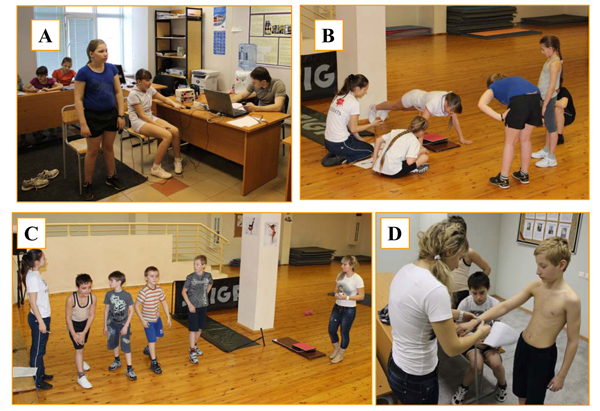
Fig. 1. The course of studies of swimmers’ physical health and physical fitness in the laboratory of biomechanics and kinesiology of Surgut state university, February 2012. А – test, variation pulse oximetry and allocation of MOC. B – Dip ups (push-ups) to determine arms’ quick strength. C – Cooper 6 minute run test. D – Circumference measurements within anthropometry.
In February and December of 2012 children were tested using a set of tests, which included four blocks: passport data (name, age, sex, date and time of testing; morphofunctional parameters (standing and sitting heights, weight, chest circumference, waist, hips, resting heart rate, resting blood pressure, carpal dynamometry, VC, Stange’s test); indicators of mental stress and health (vegetative factor, anxiety level); indices of physical fitness (aerobic, muscular endurance, flexibility, speed, coordination, speed and strength indices) (Fig. 1) and sports and technical indices (distance, time, speed) ( Fig. 2).
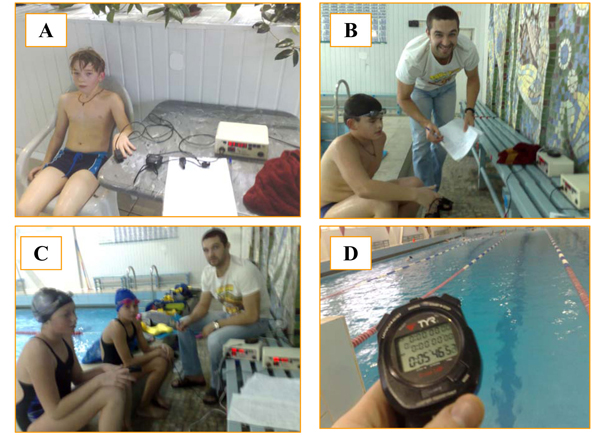
Fig. 2. The course of measurements of sports technical indices of primary school aged swimmers at the nosing of the swimming pool “Vodoley” and “Geolog”, December 2012. A – pulsometry using pulse oximeter “Elox 1SM” after a swim. B – Estimation of the state of cardiorespiratory system after swimming loading. C – Competitive pulse measurement of two athletes. D – The exterior view of the Polar heart rate monitor.
The levels of aerobic and muscular endurance, flexibility, agility, coordination, mental stress, adaptive capacity, somatotype and harmony of body built were estimated by the test results on the basis of recommendations [8]. The statistical data processing was performed using the software package Statistica_6 (StatSoft, USA). The arithmetic mean and standard deviation were calculated. One-way ANOVA and Varimax factor analysis were performed. Differences were considered significant at the significance level of p <0,05 according to Student's.
Results and discussion. The physical fitness level at the beginning and at the end of the year is shown in Fig. 3 A.B.
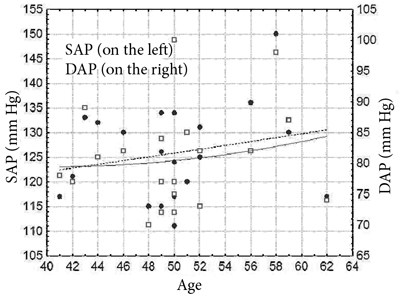
Fig. 3. The dynamics of physical fitness indices of female and male swimmers at the beginning (A) and at the end of the year (B). Lines over columns – the value of standard deviation (SD).
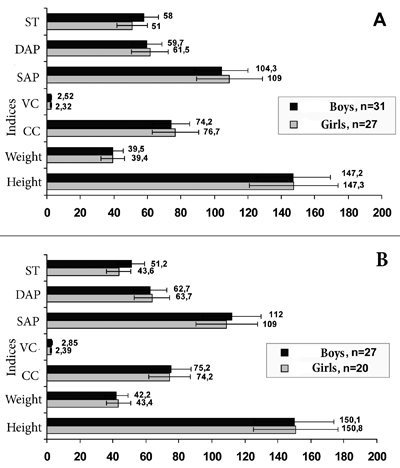
Fig. 4. The dynamics of physical health indices of male and female swimmers at the beginning (A) and at the end (B) of the year. Legend: ST – Stange’s test, sec; DAP – diastolic arterial pressure, mm Hg, SAP – systolic arterial pressure, mm Hg, VC – vital capacity, l; CC – chest circumference in pause, cm;
As shown in the data of Fig. 5, at the beginning of the year 53% of children had low and below the average level of physical health. By the end of the year 32% of children had average or above the average, and 2% of children - high level of FH. The number of athletes with the level above the average has increased by the end of the year from 6 to 23% (Fig. 5, D). By the end of the observation there has not been found any significant differences in GPH between girls and boys (p = 0,75), as well as in the level of PF (p = 0,12 and p = 0, 85, respectively) compared with the beginning of the year. Only at the beginning of the year overall physical health of boys and girls differed significantly (F (1,45) = 6,9937, p = 0,011), but this difference was not observed by the end of the year (F(1,45) = 0,10087, p = 0,752). The correlation of physical health and the level of physical fitness was described by the following equations: y = -6,1 + 0,83Х at the beginning of the year and: y = 2,28 + 0,29Х at the end of the year.
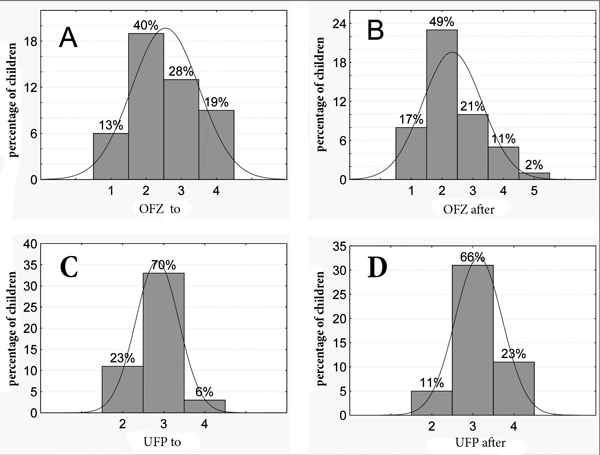
Fig. 5. The dynamics of general physical health (GPH) (A – before, B – after) and physical fitness level (PFL) (C – before, D – after) the end of the research in the group of primary school aged swimmers in percents of the total of children. On the abscissa 5 levels GPH and PFL are presented: 1 – low, 2 – below the average, 3 – average, 4 – above the average, 5 – high.
The percentage of children with high anxiety level increased by the end of the year and the ones with the average level decreased. The number of children with the high level of mental health by the end of the year decreased on average in the above average and high ranges.
The factor analysis contributed to identifying four groups of factors: size, strength and agility, hemodynamics and mental capacity amid growing anxiety. Our findings are generally consistent with those of other researchers. Most body-weight and circumference indicators of primary school aged swimmers are within the limits of 50-75 centiles, which is above average for untrained children [5]. Sports achievements in swimming depend on specific body built - body size, proportions, constitutional type, which determine buoyancy and hydrodynamic qualities and indirectly testify to strength (body circumferences, amount of muscle strength) and functional (VC, VC and body weight ratio, active body mass, muscle fiber composition) potencies of swimmers [1, 2, 6, 10].
The idea of designing the biomedical health passport is not new. As far back as at the end of the last century scientists, trainers’ community and sports leaders of several smll-populated European countries, namely the Czech Republic, Austria, Hungary, Norway, Sweden, Finland and other countries tried to realize a similar idea. Such a passport (or similar document with a different name) was needed to organize and manage sports qualification on the basis of which science-based work was launched at the early specialization of children and adolescents in a chosen sport. We believe that this work should be based on the data of monitoring of physical health, physical fitness and sports-technical results in children regularly engaged in selected sport (eg. swimming) in prepubertal, pubertal and post-pubertal periods of ontogenesis. The databases obtained in the regions in such laboratories as ours, should be processed within the Russian system of monitoring and be available on specialized websites and used by complex research groups in decision-making.
The significant contribution to the study of physiological mechanisms of the effect of physical loads in swimming was made by our scientists and experts, and in particular N.Zh. Bulgakova [1, 2, 4]. In the last quarter of the last century she wrote: "Swimming is one of the most popular sports in our country and abroad, as it is a vital skill and unique type of physical exercises, related to hygienic-fitness and tempering effect of the aquatic environment on the human body (especially on the growing body of children and adolescents). The extreme popularity of swimming is associated with the fantastic growth of records in this sport. This was promoted by a wide range of researches in swimming on bioenergy, biomechanics, hydrodynamics, anthropomotor functions etc. The studies on bioenergy are major among the stipulated ones, because endurance determines sports achievements in swimming"[4, pp. 43]. It is curious that much of what is important in swimming now has been studied 25-30 years ago, but for some reasons has not been in adequate demand and has not been supplemented by researches using modern equipment. In particular, the levels of development of components of special working capacity and their compliance were detected in elite senior swimmers and young swimmers aged 11-16 years. The age dynamics of development of the components of physical working capacity in the range of 11-20 years was defined [9]. Based on the results of the study, the carried out aerobic, aerobic-anaerobic glycolytic training loads, as well as the total amount of load are in the linear dependence on the amount of maximal oxygen uptake (maximal aerobic capacity). The volume of anaerobic alactatate loads is inversely related to the amount of the individual maximum of oxygen consumption. The impact of aerobic, aerobic-anaerobic and anaerobic alactate loads is inversely related to the absolute value of pH, characterizing anaerobic glycolytic capacity. At the same time anaerobic glycolytic loads depend directly on the maximum shift of pH: the increase of the formed products of anaerobic metabolism when doing this type of work contributes to the decrease of anaerobic glycolytic work that can be made. Special training exercises in swimming were systemized depending on the individual level of development of athletes’ aerobic and anaerobic working capacity and urgent training effect [9, 10]. The change in aerobic and anaerobic metabolism in athletes depends on selected values of parameters of the exercise being performed, duration of rest pauses and number of repetitions of exercises, i.e. the total amount of work being performed. The variation of individual parameters of physical loading has an ambiguous effect on the indices of aerobic and anaerobic metabolism at repeated muscular work.
The modes of repeated and interval loads causing the greatest increment in aerobic and anaerobic potentials were defined. The relationship of increments in the indices of special working capacity and executed volume of multi-directed training loads was analyzed [12]. Nevertheless, there is a lack of targeted studies involving primary school aged swimmers.
Hence, our studies have revealed that:
- The level of physical health of 51 % of children is low and below the average. It is hard to deal with training tasks with such a health level.
- The physical fitness level of 21% of primary school aged swimmers is below the average.
- Thanks to the factor analysis 4 groups of factors were detected – size, strength and agility, cardiovascular system and mental capacity amid growing anxiety.
- There have not been detected any significant differences in physical fitness of boys and girls aged 9-11 years.
- At the beginning of the year state of physical health was important, while at the end of the year – indices of diastiolic function of heart.
References
- Bulgakova, N.Zh. The bioenergetic profile of young elite swimmers / N.Zh. Bulgakova, N.I. Volkov, V.V. Smirnov // Teoriya i praktika fizicheskoy kultury. – 1989. – N 2. – P. 38-42. (In Russian)
- Bulgakova, N.Zh. The correlation of sports result in age groups and indices of physical development of young swimmers / N.Zh. Bulgakova, A.R. Vorontsov // Teoriya i praktika fizicheskoy kultury. –- 1977. – N 2. – P. 28-32. (In Russian)
- Bulgakova, N.Zh. Qualification and training of young swimmers / N.Zh. Bulgakova. – Мoscow: Fizkultura i sport, 1986. – 192 P. (In Russian)
- Bulgakova, N.Zh. Swimming / N.Zh. Bulgakova. Мoscow: Astrel’: AST, 2005. – 159 P. (In Russian)
- Vishnevsky, V.A. System analysis of children’s body at different phases of school ontogenesis / V.A. Vishnevsky, V.V. Apokin, D.V. Serdyukov, A.A. Varin, D.G. Zherebtsov – Мoscow: Teoriya i praktika fizicheskoy kultury i sporta, 2010. – 367 P. (In Russian)
- Volkov, V.M. Sports qualification / V.M. Volkov, V.P. Filin. – Мoscow.: Fizkultura i sport, 1983. – 176 P. (In Russian)
- Volkov, L.V. Theory and methods of children’s and youth sport / L.V. Volkov. – Kiev, Olimpiyskaya literatura, 2002. – 296 P. (In Russian)
- Gavrilov, D.N. Movement, health, way of life / D.N. Gavrilov, A.V. Malinin. Study guide. St.Petersburg. – Petropolis, 2010. – 188 P. (In Russian)
- Solomatin, V.R. Regulatory requirements and assessment of young swimmers’ perspectives / V.R. Solomatin // Teoriya i praktika fizicheskoy kultury. – 2010. – № 7. – P. 11-13. (In Russian)
- Solomatin, V.R. The view of age rules of development of morphological, functional and strength characteristics in sports qualification and long-term training of young swimmers / V.R. Solomatin, N.Zh. Bulgakova // Uchenye zapiski universiteta imeni P.F. Lesgafta. – 2010. – № 4 (62). – P. 97-102. (In Russian)
- Shwarz, V.B. Medicobiological aspects of sports orientation and qualification / V.B. Shwarz. S.V. Khruschev. – Мoscow: Fizkultura i sport, 1984. – 152 P. (In Russian)
- Saavedra J.M. A multivariate analysis of performance in young swimmers / J.M. Saavedra, Y. Escalante, F.A. Rodríguez // Pediatr. Exerc. Sci. – 2010. – V. 22, N 1. – P. 135–151.
Author’s contacts: apokin_vv@mail.ru

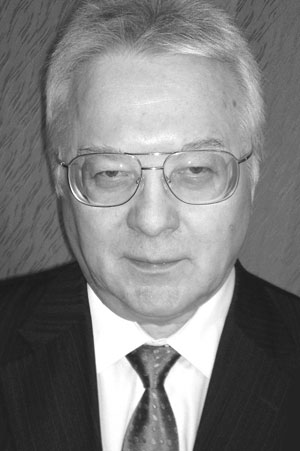

 Журнал "THEORY AND PRACTICE
Журнал "THEORY AND PRACTICE